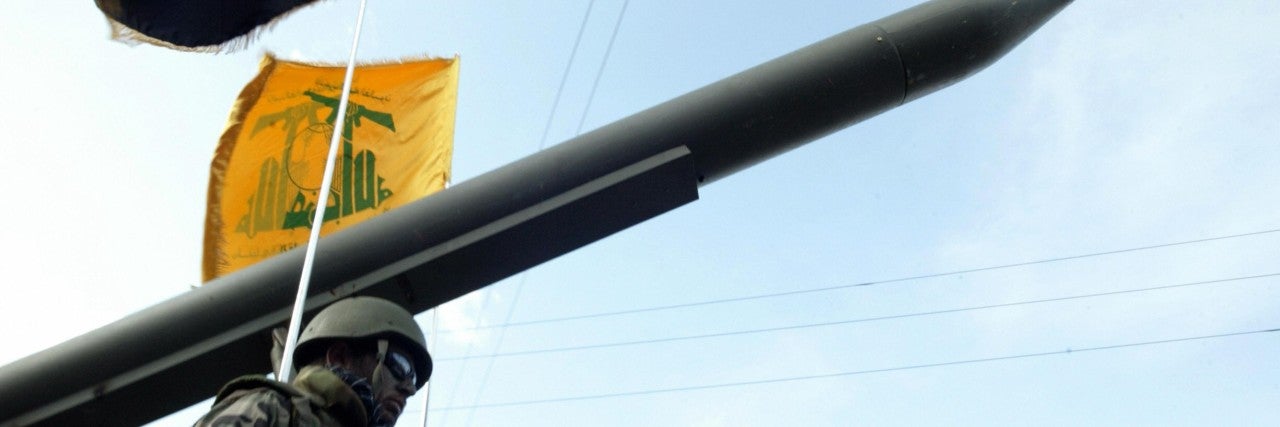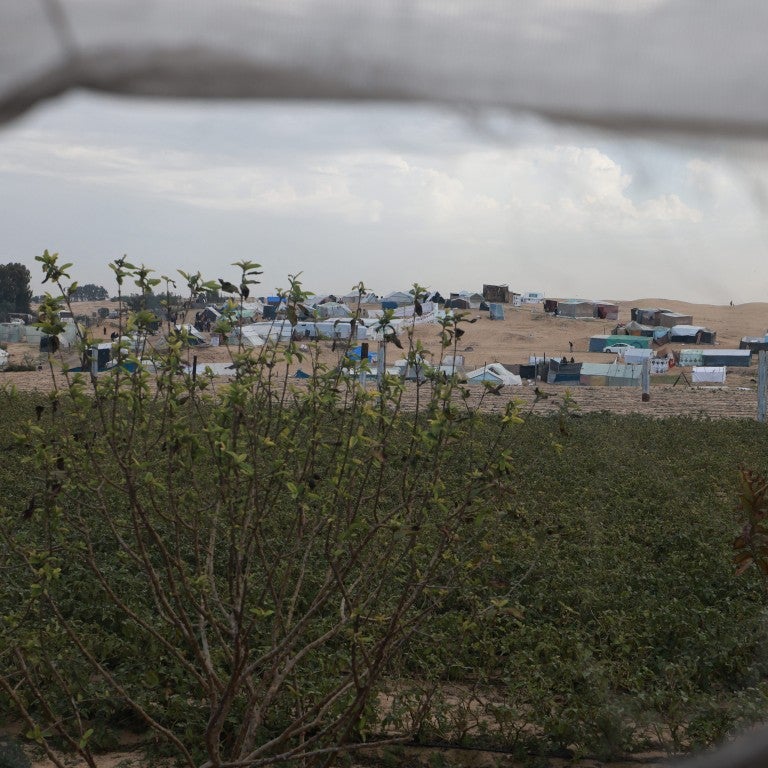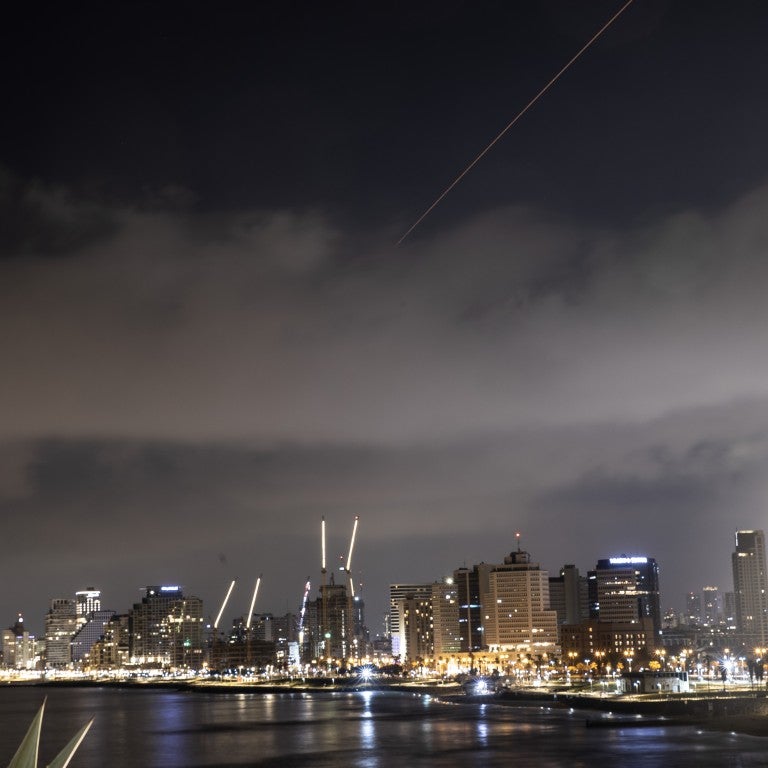March 12, 2024
The Iranian-backed anti-Israel and antisemitic Hezbollah terror army in Lebanon has amassed an arsenal of rockets, missiles, and mortars with more firepower than many NATO armies.
Hezbollah terrorists use this weapons cache to murder Israeli civilians and attack Israeli military bases and infrastructure that are critical to the defense of the Jewish state.
Here is what to know about Hezbollah and the threat it poses to Israel.
What do we know about Hezbollah’s firepower?
Hezbollah’s arsenal of weapons poses a direct threat to Israeli cities, strategic sites, and civilian population centers and could be activated by the Iran-backed terror group at any time.
The arsenal is assessed to have up to 150,000 warheads (some estimates put it up to 200,000), which means that Hezbollah could fire hundreds, if not a few thousand, rockets per day at Israel.
By comparison, the combined arsenal of Hamas and Palestinian Islamic Jihad (PIJ) on the eve of the current war was estimated at between 15,000 to 20,000 rockets.
Hezbollah also is equipped with unmanned aerial vehicles (UAVs) with an estimated arsenal of at least 2,000 UAVs.
What is the latest on tensions between Israel and Hezbollah?
Over the last five months, Israel and Hezbollah have engaged in a low-intensity battle along the border, but fears of an escalation are growing.
Since October 8, Hezbollah has fired more than 3,000 rockets at Israeli civilian and military targets. Additionally, the terror group has launched more than 600 anti-tank missiles and drones at Israeli territory. In response, Israel has struck more than 4,500 Hezbollah targets in both Lebanon and Syria, killing more than 300 Hezbollah terrorists, including five senior commanders. On the Israeli side, six civilians and nine IDF soldiers and reservists have been killed.
Over 80,000 Israelis have been evacuated from the northern border since October 8, due to the Hezbollah threat.
While there has been a long list of Hezbollah attacks, the growing frequency and intensity of attacks appear to be escalating in recent weeks, with the IDF vowing a more forceful response.
On Feb. 8, Hezbollah fired 30 rockets at northern Israel, just hours after an Israeli drone hit a Hezbollah senior commander. That strike was reportedly in retaliation for an earlier Hezbollah launch at an Israeli military base that wounded three IDF soldiers.
On Feb. 12, two Israelis were seriously wounded when a Hezbollah rocket hit the northern Israeli town of Kiryat Shmona. Two days later on February 14, another Hezbollah barrage killed one person and injured at least eight in a strike on the Israeli city of Safed and a nearby army base.
More recently, Israel has stepped up attacks in northeastern Lebanon's Baalbek, a Hezbollah stronghold.
On February 26, Hezbollah claimed to fire 60 rockets at an Israeli military base in the Golan Heights. The strike was reportedly in retaliation for an Israeli airstrike in Lebanon's Bekaa Valley, that killed at least two Hezbollah terrorists, in what was reported to be the deepest attack into Lebanese territory since October 8.
On March 12, Hezbollah fired more than 100 rockets into northern Israel, one of the heaviest barrages yet.
Top Israeli officials have repeatedly threatened to go to war in Lebanon following the IDF’s campaign to rescue hostages and dismantle Hamas in Gaza, to push Hezbollah away from the border, north to the Litani River, per UN Security Council Resolution 1701, which was enacted to end the 2006 Second Lebanon War.
The head of the IDF’s Northern Command Maj-Gen. Ori Gordin has indicated that the IDF’s goal “to change the security situation in the north in a way that will allow the residents to return safely and with a sense of security,” and said that the IDF is continuing “to prepare for the expansion of the war and going on the offensive.”
Can Hezbollah target Israeli cities like Tel Aviv and Jerusalem?
Unlike Hamas, which largely possesses crude and inaccurate short-range rockets that can occasionally hit Tel Aviv and Jerusalem, Hezbollah has a wide range of advanced rockets and missiles that can hit anywhere in Israel, including major population centers like Haifa, Jerusalem, and Tel Aviv, with deadly precise accuracy.
This includes approximately 40,000 short-range rockets (15-20 km.), approximately 80,000 medium-to-long range (200-300 km.), and a limited number of long-range Scud C and D missiles (700 km.) from Syria.
This means Hezbollah can strike practically any point in Israel (the country is 470 kilometers in length), and has many more long-range projectiles than Hamas or Palestinian Islamic Jihad ever did.
Hezbollah has also dispersed its rocket arsenal throughout Lebanon, making it a more difficult task for Israel to target rocket launching sites.
In southern Lebanon alone, Hezbollah has installed thousands of Grad rockets (dubbed Fajr) with ranges of 75 kilometers, Zelzal rockets (200 kilometer-range), and Fateh 110 rockets (300 kilometer-range). Many of them are dispersed across 200 Shi’ite-Lebanese villages in southern Lebanon. Other launchers are installed in Beirut, and some in the Beka’a Valley in eastern Lebanon.
How advanced are Hezbollah’s rockets?
Unlike Hamas, whose main arsenal of Qassam rockets does not have guidance systems and is fired indiscriminately at Israel, Hezbollah has a level of precise firepower possessed by only a few major military powers in the world.
Traditionally, only great powers could direct powerful warheads precisely at targets from long ranges, but today, thanks to Iranian support and technology, including navigation systems for guided missiles, this ability is also possessed by Hezbollah.
According to the Alma Center, Hezbollah possesses several hundred advanced conventional weapons (ACWs), including converted medium-range Fatah 110 missiles with precise guidance systems, allowing them to strike within a 10 square meter accuracy level, carrying a half-ton warhead.
Israeli authorities have expressed concerns about "suitcases" being smuggled into Lebanon that are filled with guidance kits that can transform unguided rockets into precision-guided missiles. These kits, which include the installation of navigation fins on rockets, significantly enhance the accuracy of already powerful rockets.
Hezbollah possesses cruise missiles as well as advanced coast-to-ship missiles, including the supersonic Russian-made Yakhont missiles, which can also be used to strike targets on land, and anti-aircraft missiles.
Where do Hezbollah’s rockets come from?
As of 2020, Iran provided $700 million per year to Hezbollah, according to the U.S. State Department, dwarfing the $100 million it gives to Hamas and Palestinian Islamic Jihad annually.
Iran supplies Hezbollah with rockets through various means, employing both direct and indirect methods to ensure the delivery of weaponry to the Lebanese terror group. Direct shipments of rockets occur via land, air, or sea routes, with efforts made to conceal the weapons within cargo shipments or through clandestine channels.
Additionally, Iran utilizes Syria as a transit point, taking advantage of the close ties between the Syrian government and Hezbollah, or employing proxy networks and intermediaries to facilitate the transfer of arms. Smuggling, both through established networks and across borders, is also believed to play a significant role in the supply chain.
For years, Israel has carried out airstrikes in Syria to disrupt this smuggling network and target the Islamic Revolutionary Guard Corps (IRGC) forces that are involved.
At the same time, Hezbollah's own domestic production capabilities, aided by IRGC expertise, enable the group to manufacture rockets locally.
Can Israel’s Iron Dome protect from Hezbollah rockets?
Yes, but only to an extent.
Because of Hezbollah’s large arsenal of rockets and ability to fire hundreds or even thousands per day, Israel's air defenses would have to focus on protecting important places like strategic and military sites.
This means Israeli civilians would have to use safe rooms and bomb shelters more often, and air defense systems Iron Dome wouldn't be as effective because they'd be overwhelmed and prioritizing strategic and military sites.
Even at Iron Dome’s current estimated interception rate of some 90%, this would mean 100 out of 1,000 rockets would get through.
Additionally, these barrages could deplete Israel’s Iron Dome interceptors and David’s Sling missiles within days of fighting, leaving Israel exposed to further rocket fire without a missile defense system.
According to former Israeli Air Force Air Defense Array Commander Brig. Gen. (ret.) Zvika Haimovich, even the ability to hit a small number of vital strategic targets in a war is sufficient to pose an intolerable threat. Examples include power plants, state symbols like the Knesset, air force bases, and commercial centers.





